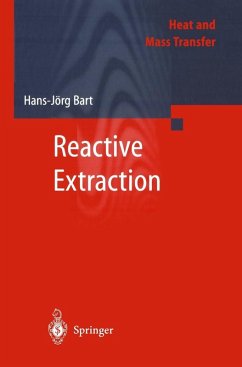This booklet is designed to bridge the gap between handbooks and technical literature and aims at graduate students or experienced readers. Commercial flow sheeting simulation software is increasingly available and is used in the early steps of process design in industry. As to this, more sophisticated and precise models based on activities instead of concentrations should be used. After an introductory chapter there is in Chapter 2 an intensive discussion of reactive phase equilibria of ionic and non-ionic solutes based on chemical potentials. Chapter 3 introduces to multicomponent diffusion and mass transfer. However, the main focus is on the reactive mass transfer on rigid and mobile surfaces where the interfacial reaction, molecular diffusion and adsorption layers are decisive. The respective extraction of zinc with a cation exchanger and of acetic acid with an anion exchanger is discussed as case studies. Since adsorption layers and surfactants have a major impact on liquid-liquid extraction efficiency, the final chapter reviews several tech niques which make use of polymeric species in an extractive process. A short review is also given on extraction apparatus and the hydrodynamics (hydraulic design, droplet populance balances) of columns. Much of the booklet is based on the PhD works of C. Czapla (2000), G. Modes (2000), H. Klocker (1996), T. Kronberger (1995), M. Marters (2000), M. Roos (2000), M. Traving (2000) and B. Wachter (1996) who I wish to thank for their fruitful contributions.
Dieser Download kann aus rechtlichen Gründen nur mit Rechnungsadresse in A, B, BG, CY, CZ, D, DK, EW, E, FIN, F, GR, HR, H, IRL, I, LT, L, LR, M, NL, PL, P, R, S, SLO, SK ausgeliefert werden.
From the reviews: "Different extraction systems have been dealt with ... . A handy list of various solvent-selection criteria has been included. ... Nomenclature adopted has been given in the beginning of the book. The appendix completes the gap and also records useful physical and chemical properties. The bibliography is exhaustive. ... The monograph should be useful for researchers in this area." (S.C. Rajvanshi, Zentralblatt MATH, Vol. 1009, 2003) "The availability of liquid ion exchangers has given rise to new approaches in hydrometallurgy, chemical and biochemical industries. This book is largely based on results from a series of PhD works in Prof. Bart's laboratory. ... it conveys the cumulative know how and insights from many years of activity in the field. The book aims at bridging the gap between the dispersed technical literature and the application of this information. It succeeds largely in this effort ... . certainly an excellent guide." (European Journal of Mechanical and Environmental Engineering, Vol. 47 (2), 2002) "This book is designed to bridge the gap between handbooks and technical literature and is intended to serve the research needs of both academic and industrial scientists and graduate students. ... A brief summary on current developments and not common extraction techniques is also offered. A program for column design which is available from the author's homepage is described ... ." (Chemie-Anlagen und Verfahren, Issue 2, 2002)

